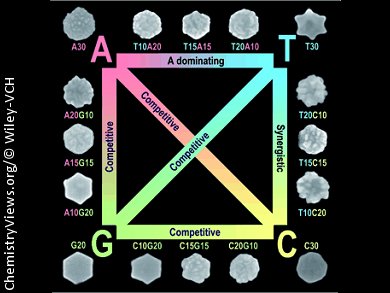DNA Template for Controlled Gold Nanoparticle Morphology
Gold is not just the material of choice for pretty jewelry; it is also used in technology, for example in nanoscopic particles for applications such as catalysis, biomedicine, and sensors. In the journal Angewandte Chemie, a team of American and Chinese researchers has now demonstrated that the morphology of gold nanoparticles can be controlled when they are synthesized in the presence of DNA. Depending on the DNA sequence used, the shape and surface roughness can be varied.
Because of its defined structure, DNA is often used as a “template” or “scaffold” for the production of nano-objects and nanomaterials. A team led by Yi Lu from the University of Illinois at Urbana-Champaign, USA, and Jinghong Li from the Tsinghua University Beijing, China, have now used gold nanoparticles to demonstrate that DNA can influence the morphology of nanomaterials as well as their structure and functionality.
In order to produce gold nanoparticles, the researchers use a solution of a gold salt to which they add a mild reducing agent and tiny prismatic gold seed crystals. The reducing agent reduces the gold ions of the salt to elemental gold, which is deposited onto the seed crystals. In the presence of short DNA strands, these crystallize further to form larger, defined nanoparticles. In the absence of DNA they form significantly larger, irregularly shaped agglomerates instead.
Identity of the Bases is Key
Interestingly, the length of the DNA strands is irrelevant whereas the identity of the bases (adenine, cytosine, guanine, and thymine) in them is not. If the researchers add DNA that only contains guanine, the resulting nanoparticles are flat hexagons; DNA made of pure thymine produces tiny six-pointed stars with a smooth surface; pure adenine leads to the formation of rounded, rough particles; and cytosine generates round, flat platelets. In each case the particles are of uniform size and shape.
The scientists also tested DNA strands made from two different bases. In most cases the base that is present in larger amounts dominates. However, the combination of thymine and cytosine is interesting. These two bases apparently work synergistically because together they produce a new form: flower-like nanoparticles that are thinner in the middle and thicker at the edges. Increasing the proportion of thymine makes the edges thicker.
“Our work could provide a new method for synthesizing nanoparticles with predictable structures with fine-tuned morphologies for widespread applications,” says Lu. “Nanoparticles with complex shapes and rough surfaces have recently been shown to have enhanced performance as catalytic components and support materials for analytical processes like Surface-Enhanced Raman Spectroscopy (SERS). They are also better absorbed by cells.”
- Discovery of the DNA “Genetic Code” for Abiological Gold Nanoparticle Morphologies,
Zidong Wang, Longhua Tang, Li Huey Tan, Jinghong Li, Yi Lu,
Angew. Chem. Int. Ed. 2012.
DOI: 10.1002/anie.201203716



